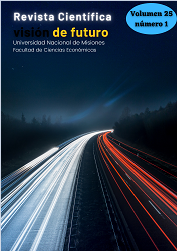Comparative study of the components of quality of working life
Keywords:
Quality of working life; Dynamic processes; Total quality; Continuous Improvement; Teleworking.Abstract
Our line of research in 17 years has been total quality and its problems in SMEs of Córdoba. Until now, we had not studied the concept of Quality of Working Life (QWL). This project is part of a larger one that integrates the Current Population Challenges program, where we have included the QWL, because we understand that a current population challenge is to study the factors that affect it: unemployment, underemployment, precarization, economic crisis, gender issues that have not been surpassed in years, preconceptions about the lower capacity of female decision-making against the male, among others. In recent months, an additional, unthinkable and serious factor, such as Covid-19 quarantine, has come to further complement people's work and thus this concept. The QWL study is a young field, where authors do not agree on identical dimensions and variables for measurement. As a first stage, we have compared updated studies and added factors due to the impact of total quality and Covid-19 quarantine, for building a superior model for decision-making and a questionnaire which we have probed in some organizations.References
Becerra Gualdrón, J. (2015): Calidad de Empleo con Enfoque de Género: Propuesta de un Marco Conceptual. Universidad Pedagógica y Tecnológica de Colombia (Colombia).
Autor (2008): Gestión de Calidad Total: Cambios en los Procesos Dinámicos de las Organizaciones. 17º Congreso Nacional de Profesionales en Ciencias Económicas.
Autor (2008): Gestión de Calidad Total, Asociación Cooperadora FCE, Córdoba.
Chiavenato, I. (2007): Administración de recursos humanos. El capital humano de las organizaciones, 8ª Edición, McGraw-Hill, México.
Cruz Velazco, J. E. (2018): La calidad de vida laboral y el estudio del recurso humano: una reflexión sobre su relación con las variables organizacionales. Pensamiento & Gestión, núm. 45, Fundación Universidad del Norte - Barranquilla, Colombia.
Davis, k. y Newstrom, J. (2003): Comportamiento Humano en el Trabajo. Comportamiento Organizacional, 10ª Edición, McGraw Hill, México.
Dombrowski, U. y Mielke, T. (2014): Variety Management in Manufacturing. Proceedings of the 47th CIRP Conference on Manufacturing Systems, Procedia CIRP 17 (2014) 565 – 570.
Evans, J. y Lindsay, W. (2005): Administración y Control de la Calidad. Thompson International, 6ª Edición, México.
Fea, U. (1995): Competitividad es Calidad Total. Manual para salir de la crisis y generar empleo, Alfaomega Marcombo, México.
Fernández, J. A. (2005): Lecciones de El Arte de la Guerra, Revista Gestión, Vol. 10, Nº 1, Pág. 94-99.
González R., Hidalgo G., Salazar J., Preciado M. (2010): Elaboración y Validación del Instrumento para Medir Calidad de Vida en el Trabajo CVT-GOHISALO. Ciencia & Trabajo. Año 12, | Número 36.
Gore, E. (2006): Aprendizaje y Organización, Ediciones Granica, Buenos Aires.
Granados, I. (2011): Calidad de Vida Laboral: Historia, Dimensiones y Beneficios. Revista II PSI, Facultad de Psicología, Universidad Mayor San Marcos, Perú.
Hernandez Sampieri, R., Fernández Collado, C. y Baptista Lucio, M. (2010): Metodología de la Investigación, McGraw-Hill. México.
Hill, Ch. y Jones, G. (2011): Administración Estratégica. Un enfoque integrado. 9ª Edición. Cengage Learning. México.
Martínez L., Oviedo O. y Luna C. (2013): Condiciones de trabajo que impactan en la vida laboral. Salud Uninorte, vol. 29, núm. 3, 2013, pp. 542-560. Universidad del Norte. Barranquilla, Colombia.
Pfeffer, J. (1995): Competitive Advantage through People, Harvard Business School Press, U.S.A.
Riccardi, R. (1993): La Cultura de la Calidad Total, 3ª Edición, Ediciones Fausto. Buenos Aires.
Robbins, S.P. (2017): Comportamiento Organizacional. Conceptos, Controversias y Aplicaciones. 17ª Edición. Pearson. México.
Saravia Sánchez, F. (Coord.) (2013). Métodos de Investigación Social y de la Empresa. Editorial Pirámide. Madrid.
Uriel, E. y Aldas, J. (2005): Análisis multivariante aplicado. Madrid. Thomson-Paraninfo.
Published
How to Cite
Issue
Section
License
Copyright (c) 2020 Nélida del Carmen Castellano, Esteban Damián López
The works published in this magazine are under the Creative Commons Attribution-NonCommercial 2.5 Argentina license.
Important: The author is the owner of the rights to exploit the contents of the article of his authorship.
You are free to:
Share — copy and redistribute the material in any medium or format.
Adapt — remix, transform and build from the material.
The licensor cannot revoke these liberties as long as you follow the terms of the license.
Under the following terms:
Attribution - You must give appropriate credit, provide a link to the license, and indicate if any changes have been made. You may do so in any reasonable way, but not in a way that suggests that you or your use is endorsed by the licensor.
Non-Commercial - You may not use the material for commercial purposes.
There are no additional restrictions - You cannot apply legal terms or technological measures that legally restrict others to make any use permitted by the license.




















